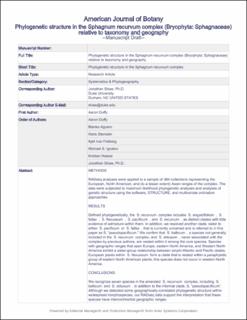| dc.description.abstract | Premise
The Sphagnum recurvum complex comprises a group of closely related peat mosses that are dominant components of many northern wetland ecosystems. Taxonomic hypotheses for the group range from interpreting the whole complex as one polymorphic species to distinguishing 6–10 species. The complex occurs throughout the Northern Hemisphere, and some of the putative species have intercontinental ranges. Our goals were to delimit the complex and assess its phylogenetic structure in relation to morphologically defined species and intercontinental geography.
Methods
RADseq analyses were applied to a sample of 384 collections from Europe, North America, and Asia. The data were subjected to maximum likelihood phylogenetic analyses and analyses of genetic structure using the software STRUCTURE and multivariate ordination approaches.
Results
The S. recurvum complex includes S. angustifolium, S. fallax, S. flexuosum, S. pacificum, and S. recurvum as clades with little evidence of admixture. We also resolved an unnamed clade that is referred to here as S. “pseudopacificum.” We confirm that S. balticum and S. obtusum are nested within the complex. Species with bluntly acute to obtuse stem leaf apices are sister to those with acute to apiculate leaves. Most of the species exhibit some differentiation between intraspecific population systems disjunct on different continents.
Conclusions
We recognize seven species in the amended S. recurvum complex, including S. balticum and S. obtusum, in addition to the informal clade S. “pseudopacificum.” Although we detected some geographically correlated phylogenetic structure within widespread morphospecies, our RADseq data support the interpretation that these species have intercontinental geographic ranges. | |
